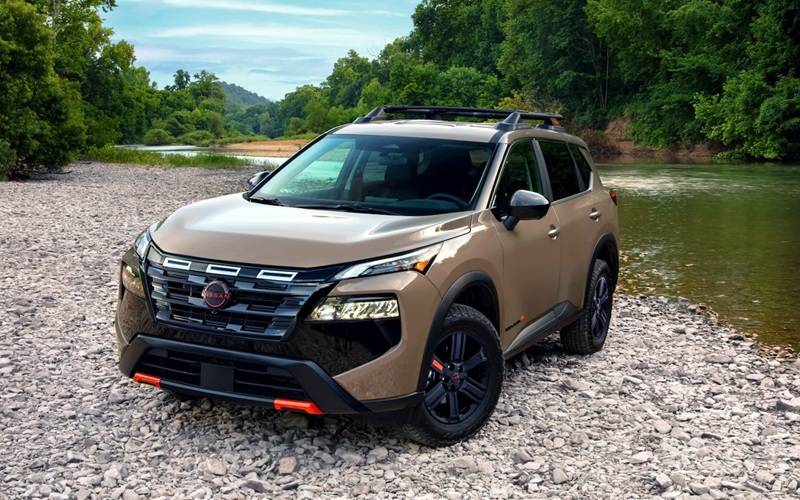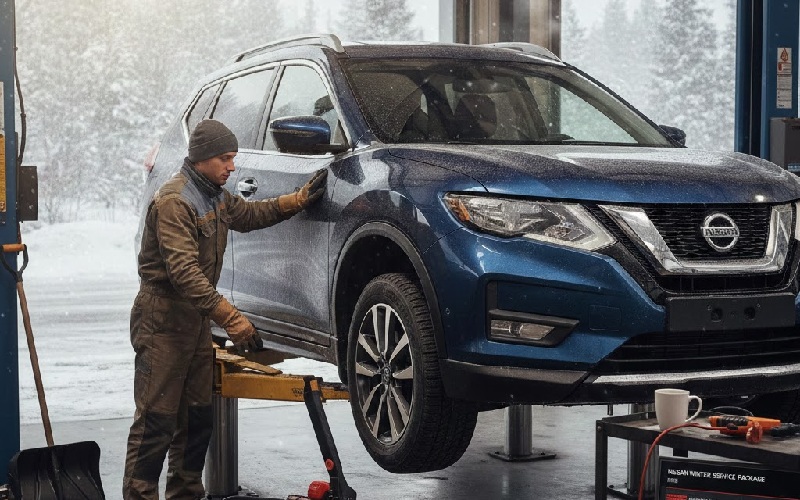Nissan Pathfinder Brake System in Hard and Rugged Terrain
The Nissan Pathfinder stands as a testament to engineering excellence, combining rugged capability with refined design to meet the demands of adventurous Canadian drivers. While many focus on engine power or all-wheel-drive systems when discussing off-road capability, the brake system plays an equally critical role in conquering challenging terrain. The advanced braking technology ensures confident […]
The Nissan Pathfinder stands as a testament to engineering excellence, combining rugged capability with refined design to meet the demands of adventurous Canadian drivers. While many focus on engine power or all-wheel-drive systems when discussing off-road capability, the brake system plays an equally critical role in conquering challenging terrain. The advanced braking technology ensures confident control whether navigating steep descents in the Rocky Mountains or traversing muddy trails after spring thaws.

The Fundamentals of Off-Road Braking
The demands placed on a braking system in hard terrain differ dramatically from everyday urban driving. On challenging surfaces, a vehicle’s brake system must contend with inconsistent traction, extreme angles, thermal stress, and potential contaminants like mud, water, and debris. The Pathfinder braking system is engineered specifically to overcome these challenges, providing reliable performance when conventional systems might falter.
Standard braking scenarios assume relatively consistent friction between tires and pavement. In off-road environments, this fundamental assumption no longer applies. Nissan engineers the Pathfinder braking system to overcome these challenges, delivering reliable performance even when conventional systems falter.
Core Components of the Pathfinder Brake System
Four-Wheel Disc Brakes with Enhanced Cooling
At the foundation of the Pathfinder braking capability are ventilated disc brakes on all four wheels. Unlike drum brakes found on some competitors, disc brakes provide superior heat dissipation – a critical factor when descending long, steep grades where brake temperatures can rise dramatically. The ventilated design allows air to flow between the friction surfaces, carrying away heat that would otherwise compromise braking performance.
The front discs feature a larger diameter than the rear, accounting for the forward weight transfer that occurs during braking. This balanced design ensures consistent stopping power even when the vehicle is heavily loaded with passengers and gear for backcountry adventures. The high-temperature brake pads maintain friction characteristics across a wide temperature range, preventing the performance degradation that can occur with lesser systems during prolonged use in challenging conditions.
Electronic Brake Force Distribution (EBD)
The Pathfinder Electronic Brake Force Distribution system continuously monitors weight distribution and adjusts braking pressure accordingly. This becomes particularly valuable in off-road scenarios where weight shifts dramatically as the vehicle navigates uneven terrain. When ascending a steep, rocky trail, weight transfers to the rear wheels; when descending, it shifts forward. The EBD system dynamically compensates for these shifts, ensuring optimal braking force at each wheel.
This intelligent system also accounts for cargo and passenger load, automatically adjusting brake pressure distribution between front and rear wheels. For Canadian adventurers packing heavy gear for remote excursions, this adaptive capability maintains predictable braking performance regardless of how the vehicle is loaded.
Anti-lock Braking System (ABS) with Off-Road Logic
While ABS technology is standard across modern vehicles, the system incorporates specialized programming for off-road conditions. Conventional ABS is calibrated for pavement, where preventing wheel lockup preserves steering control. On loose surfaces like gravel or snow, however, some wheel lockup can actually improve stopping distance by creating a wedge of material in front of the tire.
The Pathfinder ABS includes terrain-sensing capabilities that modify its intervention thresholds based on surface conditions. When navigating loose terrain, the system allows slightly more wheel slip before activating, striking the optimal balance between steering control and stopping power. This adaptive approach provides the best of both worlds – the directional control benefits of ABS with the improved stopping performance needed on challenging surfaces.
Advanced Terrain-Specific Braking Features
Hill Descent Control
One of the most valuable Pathfinder features for difficult terrain is its Hill Descent Control (HDC) system. This sophisticated technology maintains a controlled, constant speed when navigating steep descents, allowing the driver to focus entirely on steering rather than modulating the brake pedal. The system automatically applies individual brakes as needed to maintain the selected speed, typically between 4-7 km/h.
HDC proves particularly valuable on loose or slippery downhill sections where conventional braking might induce a slide. By precisely controlling each wheel independently, the system maintains traction even on inconsistent surfaces. The microprocessors controlling HDC make adjustments up to 50 times per second, responding to changes in terrain faster than any human driver could manage.
Hill Start Assist
Complementing the descent control is the Pathfinder Hill Start Assist feature, which prevents rollback when starting on inclines. When the system detects the vehicle is on a hill, it maintains brake pressure momentarily after the driver releases the brake pedal, providing time to apply the throttle without rolling backward. This proves invaluable when navigating technical terrain with frequent stops on inclines.
For off-road scenarios, this feature eliminates the need for two-foot driving techniques on steep ascents, allowing the driver to focus on throttle modulation and steering input rather than preventing rollback. The system senses the incline angle and adjusts the holding pressure, applying enough braking force to prevent movement while still letting you move forward easily when you press the throttle.
Brake-Limited Slip Differential Function
When traversing terrain with dramatically different traction levels under each wheel, the Pathfinder employs a brake-based limited-slip differential function. This system detects when a wheel begins to spin due to a lack of traction and applies brake pressure to that wheel, effectively transferring torque to wheels with better grip.
Unlike mechanical, limited-slip differentials, this brake-based system adapts instantly to changing conditions and requires no driver intervention. The precision control of individual wheel braking helps maintain forward momentum in challenging conditions like mud, snow, or uneven rocky surfaces, where a conventional open differential would allow a single wheel to spin uselessly.
Brake System Durability Features for Hard Terrain
Water and Contamination Resistance
Off-road driving frequently involves water crossings, mud, and debris – all potential enemies of braking systems. The Pathfinder brake components feature enhanced seals and protective covers that prevent contamination from affecting performance. Brake callipers include dust boots that protect pistons and seals from mud and grit, while the master cylinder reservoir prevents moisture intrusion.
The brake lines employ a double-wall construction with corrosion-resistant coating, protecting against both physical damage from rocks and chemical degradation from exposure to water and road salt – a particular concern for Canadian drivers. This comprehensive protection ensures reliable braking even after fording streams or navigating mud bogs that would compromise lesser systems.
Thermal Management
Repeated hard braking on steep descents generates tremendous heat that can lead to brake fade – a dangerous reduction in stopping power. The Pathfinder addresses this challenge through multiple thermal management strategies. Beyond the ventilated discs mentioned earlier, the system includes temperature sensors that monitor brake performance and alert the driver if temperatures approach critical levels.
The brake fluid itself is formulated to maintain consistent viscosity and vapour resistance at extreme temperatures. This high-performance fluid prevents the formation of vapour bubbles that would create a spongy brake pedal and reduce stopping power – a critical safety feature when navigating steep mountain trails.
Integration with Driving Modes
The Pathfinder braking system pairs with its selectable drive modes to optimize performance for specific terrain challenges. When you engage “Snow” mode, the braking system adjusts its intervention thresholds for reduced traction, and the transmission holds lower gears to deliver added engine-braking support.
In more challenging conditions, “Mud/Rut” mode modifies ABS operation to allow more controlled wheel slip, helping the tires clear accumulated mud that would otherwise reduce braking effectiveness. This intelligent integration ensures that all vehicle systems work together coherently to maintain control in difficult terrain.
Nissan Pathfinder: Safety and Control
The Nissan Pathfinder brake system represents a masterful integration of mechanical engineering and electronic control, specifically designed to overcome the challenges presented by hard terrain. From rocky ascents to muddy descents, the system maintains consistent performance where conventional brakes would falter. For Canadian adventurers exploring the diverse and challenging landscapes from the Rocky Mountains to the Canadian Shield, this sophisticated system provides the confidence to venture further with safety and control.
Understanding the capabilities and proper use of these advanced braking features allows Pathfinder owners to maximize their vehicle’s potential in challenging conditions. Whether navigating a technical off-road trail or simply maintaining control on a snow-covered mountain highway, the Pathfinder brake system works silently in the background, constantly adapting to provide the perfect balance of stopping power and vehicle control in all terrain conditions.
5 Facts About the Pathfinder Brake System
1. The brake system can detect the difference between gradual and sudden brake application, adjusting hydraulic pressure boost to match the driver’s apparent intentions.
2. During water crossings, the system performs periodic “dry braking” – applying slight brake pressure to remove water film from the discs, ensuring immediate stopping power when needed.
3. The electronic brake controller contains over 200,000 lines of code dedicated to analyzing terrain conditions and optimizing brake performance accordingly.
4. The brake components undergo testing in temperatures ranging from -40°C to +60°C to ensure reliable operation in all Canadian climate conditions.
5. When driving on loose surfaces, the brake system can detect impending skids within 15 milliseconds – faster than the human eye can blink.
Common Questions About the Pathfinder Brake System in Hard Terrain
How does the Pathfinder brake system differ from standard passenger vehicles?
- This SUV incorporates several off-road-specific enhancements, including specialized ABS programming that allows appropriate wheel slip on loose surfaces, enhanced cooling for repeated heavy braking on descents, and superior sealing against water and contaminants. The system also features terrain-specific driving modes and hill descent control, features not typically found in road-focused vehicles. These features work together to maintain braking performance in conditions that would severely compromise conventional systems.
What maintenance is recommended for the brake system after hard off-road use?
- After you tackle heavy off-road driving, especially through water crossings or muddy terrain, thoroughly inspect the brake system. Check for debris around the callipers and rotors, inspect the brake lines for damage from rocks or branches, and bleed the system if you suspect water contamination. Test the brake fluid for moisture content, since absorbed water lowers its boiling point and can compromise performance on your next off-road run.
Can the Hill Descent Control be used on all types of terrain?
- While extremely versatile, Hill Descent Control performs best on relatively uniform slopes. On extremely technical terrain with large obstacles, driver modulation of the brakes may still be preferable for navigating specific features. The system works effectively on most challenging surfaces, including loose rock, gravel, snow, and mud, but extremely uneven terrain with sudden drops or large obstacles may require traditional braking techniques combined with careful spotting.
How does the brake system manage the additional weight of off-road accessories?
- The Electronic Brake Force Distribution system automatically detects and compensates for added weight from accessories like roof racks, winches, or loaded cargo areas. The system adjusts hydraulic pressure to each wheel based on the detected weight distribution, ensuring consistent stopping performance regardless of how the vehicle is equipped. For significant accessories, recalibration at a Nissan service center may provide optimal performance tuning.
What happens to the Pathfinder brake system during water crossings?
- The brake system is designed to maintain functionality even during water crossings up to its rated fording depth. Seals protect critical components from water intrusion, while the system automatically compensates for the temporary reduction in friction when brake components become wet. After exiting water, the system may automatically apply slight brake pressure to dry the rotors and restore full braking capability more quickly.
Disclaimer: Content contained in this post is for informational purposes only and may include features and options from US or international models. Please contact the dealership for more information or to confirm vehicle, feature availability.


